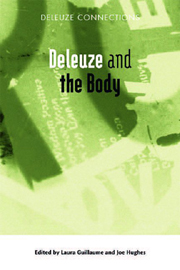Book contents
- Frontmatter
- Contents
- Introduction: Pity the Meat?: Deleuze and the Body
- DELEUZISM
- PRACTICAL DELEUZISM
- 6 The ‘Virtual’ Body and the Strange Persistence of the Flesh: Deleuze, Cyberspace and the Posthuman
- 7 ‘Be(come) Yourself only Better’: Self-transformation and the Materialisation of Images
- 8 An Ethico-Aesthetics of Heroin Chic: Art, Cliché and Capitalism
- 9 Multi-Dimensional Modifications
- 10 Dance and the Passing Moment: Deleuze's Nietzsche
- Notes on Contributors
- Index
8 - An Ethico-Aesthetics of Heroin Chic: Art, Cliché and Capitalism
from PRACTICAL DELEUZISM
Published online by Cambridge University Press: 12 September 2012
- Frontmatter
- Contents
- Introduction: Pity the Meat?: Deleuze and the Body
- DELEUZISM
- PRACTICAL DELEUZISM
- 6 The ‘Virtual’ Body and the Strange Persistence of the Flesh: Deleuze, Cyberspace and the Posthuman
- 7 ‘Be(come) Yourself only Better’: Self-transformation and the Materialisation of Images
- 8 An Ethico-Aesthetics of Heroin Chic: Art, Cliché and Capitalism
- 9 Multi-Dimensional Modifications
- 10 Dance and the Passing Moment: Deleuze's Nietzsche
- Notes on Contributors
- Index
Summary
the drug addict … look at the representations of these bodies in fashion … this culture is really completely schizoid! … all these heroin ads … these bodies that are leaking … the junkie body leaks all over the place … Deleuze would have very hard things to say against this junkie thing.
(Braidotti, no date)A thin, semi-dressed young woman kneels awkwardly, her body twisted and bent forward over the side of an armchair in what appears to be a fairly dingy lounge-room. Surrounding her, and taking up most of the photograph, is a grimy red carpet, marked with what seem to be cigarette burns. The woman's exposed feet are covered in dirt and her face is shiny, as though coated in a fine layer of sweat. The photo's strange angle creates a sense that the room is spinning, and accentuates the gravitational weight of her thin, unsteady body as she tries unsuccessfully to push herself up. The unusual framing also suggests that the photo has been taken by an amateur (a friend of the woman, perhaps) rather than by a fashion photographer. In fact, aside from the designer underwear the woman is wearing, the image – by UK photographer Corinne Day - has little to suggest that it is a fashion advertisement at all.
During the 1990s, documentary-style images such as this – with models looking thin, anxious, bruised, doped-out and unwell – became commonplace in fashion magazines.
- Type
- Chapter
- Information
- Deleuze and the Body , pp. 165 - 187Publisher: Edinburgh University PressPrint publication year: 2011

